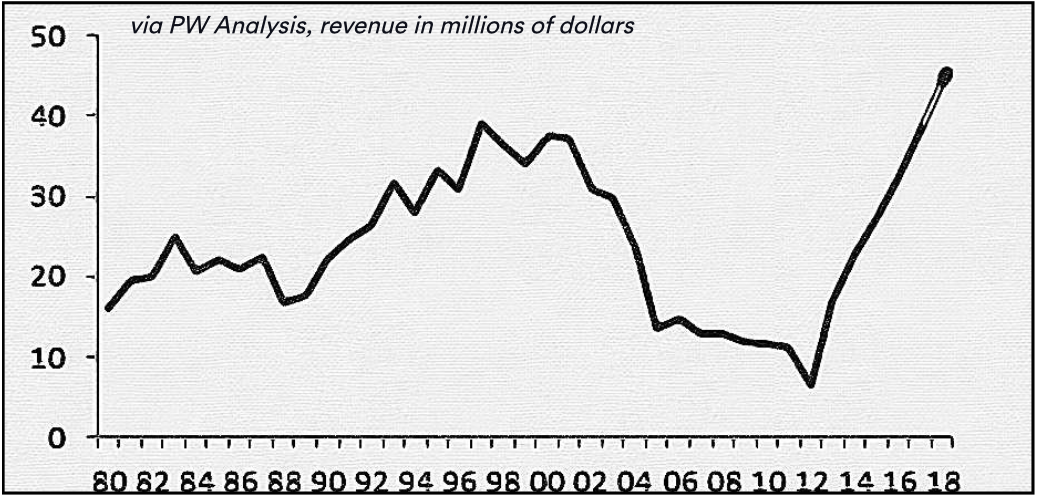NJPW’s Long-term Booking is Boosting Its Fortunes
By: Walter Yeates
Captivating, long story arcs have proven successful in various mediums of entertainment. In novels, TV, film, or video games – an enthralling plot hooks people, turning them into long-term fans of a franchise. Professional wrestling is no different, especially for promotions where the business model relies on in- person attendance to bolster financial growth and international expansion.
New Japan Pro Wrestling has seen ebbs and lows in attendance since its inception in 1972; however, the company had never seen such a drastic increase in attendance and revenue as when former four-time IWGP Junior Heavyweight Tag- Team Champions Gedo and Jado took over the creative department in early 2011.
🤘#njpw #njcup pic.twitter.com/nlVjSbaLIv
— たくや〜Photo acct. (@Pw_photo2mass) March 16, 2021
A look at the company’s official attendance figures illustrates this sharp increase in live gate performance: 2015 (210,481), 2016 (312,278), 2017 (360,333), 2018 (428,344), 2019 (464,139).
The 2020 figure was drastically lower due to the global COVID-19 pandemic, which forced the cancellation of 64 events. Still, NJPW sold over 180,000 tickets throughout the calendar year. In combination with Bushiroad purchasing a controlling stake in NJPW on January 31, 2012, Gedo and Jado have boosted live attendance figures from approximately 100,000 in 2011 to a staggering 464,139 in 2019.

New Japan’s attendance boom began with the rise of “Rainmaker” Kazuchika Okada and his program against a key figure in wrestling history, Hiroshi Tanahashi. Many questioned whether Okada could beat Tanahashi for the IWGP Heavyweight Championship during The New Beginning in Osaka on February 12, 2012.
It’s a premier example of the sort of long-term narratives that make puroresu special. One can think back to Tomoaki Honma’s story and his determination to will through tough matches, in spite of falling shot of winning key victories in singles competition. The joke was always on Honma, whose kokeshi headbutt has since become the delight of fans around the world. But then the payoff occurred: His G1 Climax 25 victory over “Stone Pitbull” Tomohiro Ishii on August 12, 2015 caused an eruption from the crowd inside Korakuen Hall in Tokyo for his first and only win during the campaign. What made the victory special was Honma having le t G1 Climax 24 winless and being on the brink of repeating the infamous feat, despite displaying courageous amounts of “fighting spirit. and coming within inches of securing victory over less-heralded grapplers. His victory catapulted Honma and Great Bash Heel (GBH) tag-team partner Togi Makabe to their first World Tag League trophy in 2015.
Then, they achieved a subsequent win in a dazzling Wrestle Kingdom 10 bout and captured the IWGP Heavyweight Tag-Team Championships on January 4, 2016.
More recently, YOSHI-HASHI has seen a similar type of underdog story, culminating with him winning the NEVER Openweight 6- Man Tag Team Championship on August 9, 2020 with fellow CHAOS members Ishii and Hirooki Goto. YOSHI-HASHI is not positioned as a marquee draw, but his narrative of refusing to stay down has led to a mass following, especially in Japan. His rise to the championship was marked by several years of inability to string together key victories that would advance his career, beginning with an upset victory over Kenny Omega during G1 Climax 26 on July 22, 2016.
Omega was at the center of another well conceived long-term narrative, which saw him advance from IWGP Junior Heavyweight Champion to a marquee draw who headlined several Wrestle Kingdom events, despite detractors outside of Japan questioning whether a foreign-born wrestler could succeed in such a key role within NJPW. Similarly, long- term programs over the years featuring AJ Styles and Chris Jericho had set up NJPW trueborns Kazuchika Okada and Tetsuya Naito for success in the United States, helping lay the foundation for the NJPW Strong weekly episodic program and future television deals within the lucrative region.
Both the marketing prowess of Bushiroad and the superb in-ring work by members up and down the roster are factors in NJPW’s boom period, but it’s the long-term narratives that have captured the hearts and minds of key demos in Japan and abroad.
This article first appeared in Monthly Puroresu Issue #3

